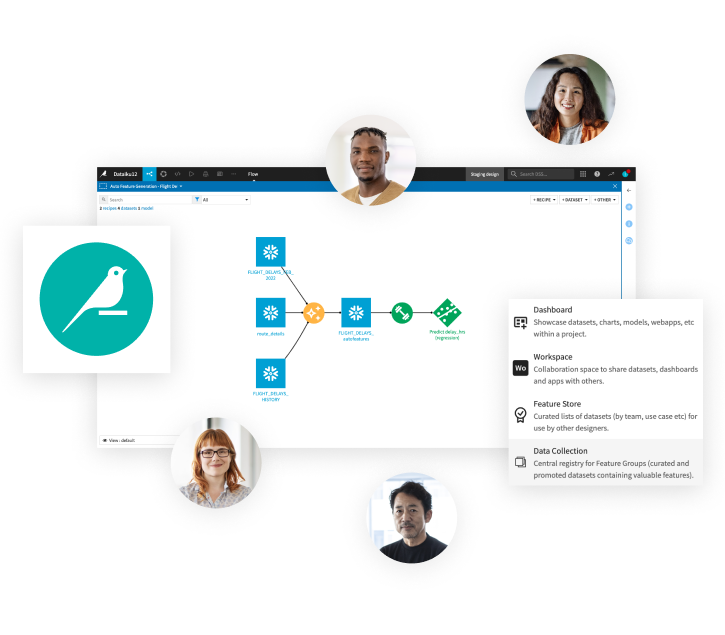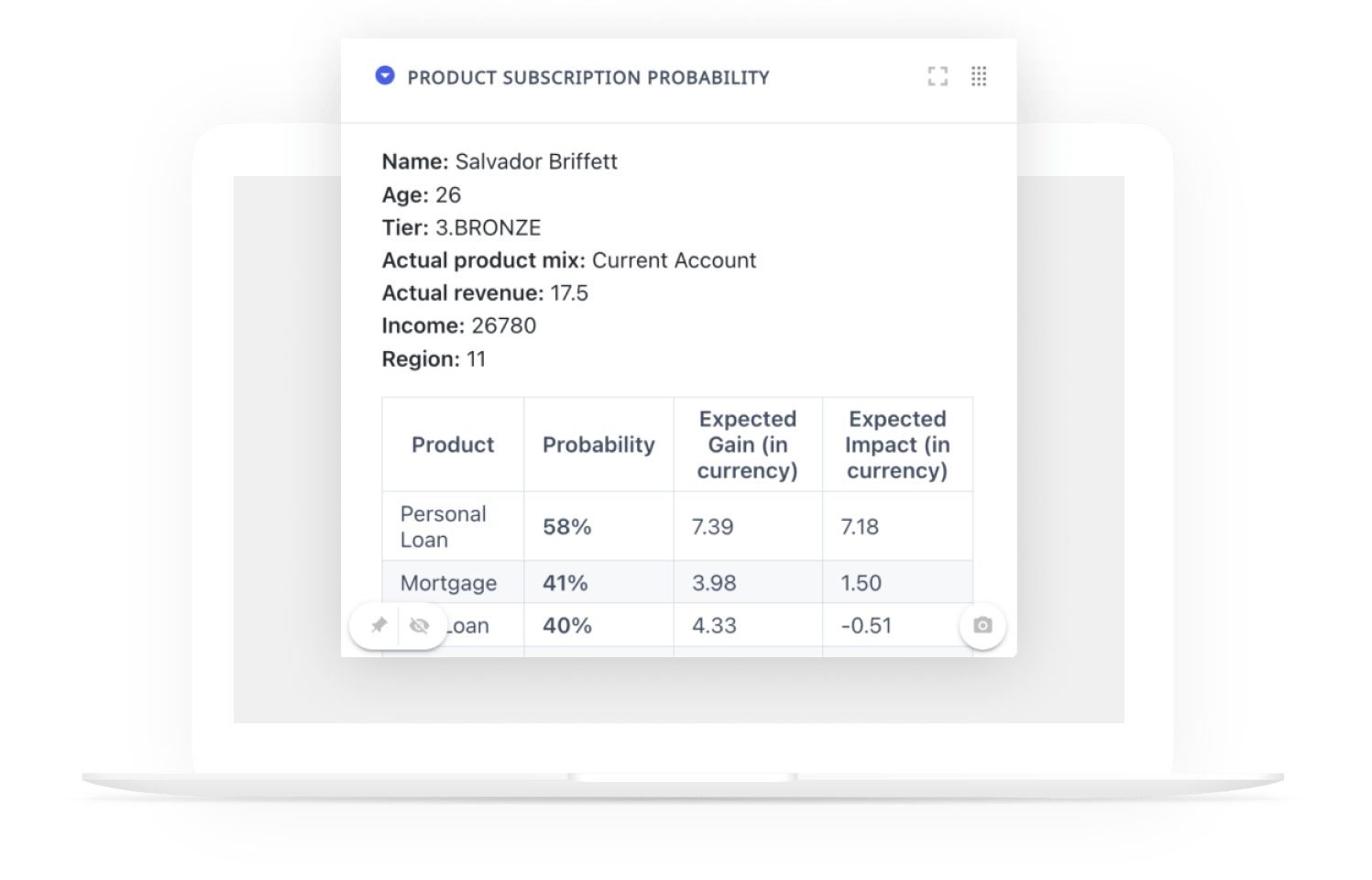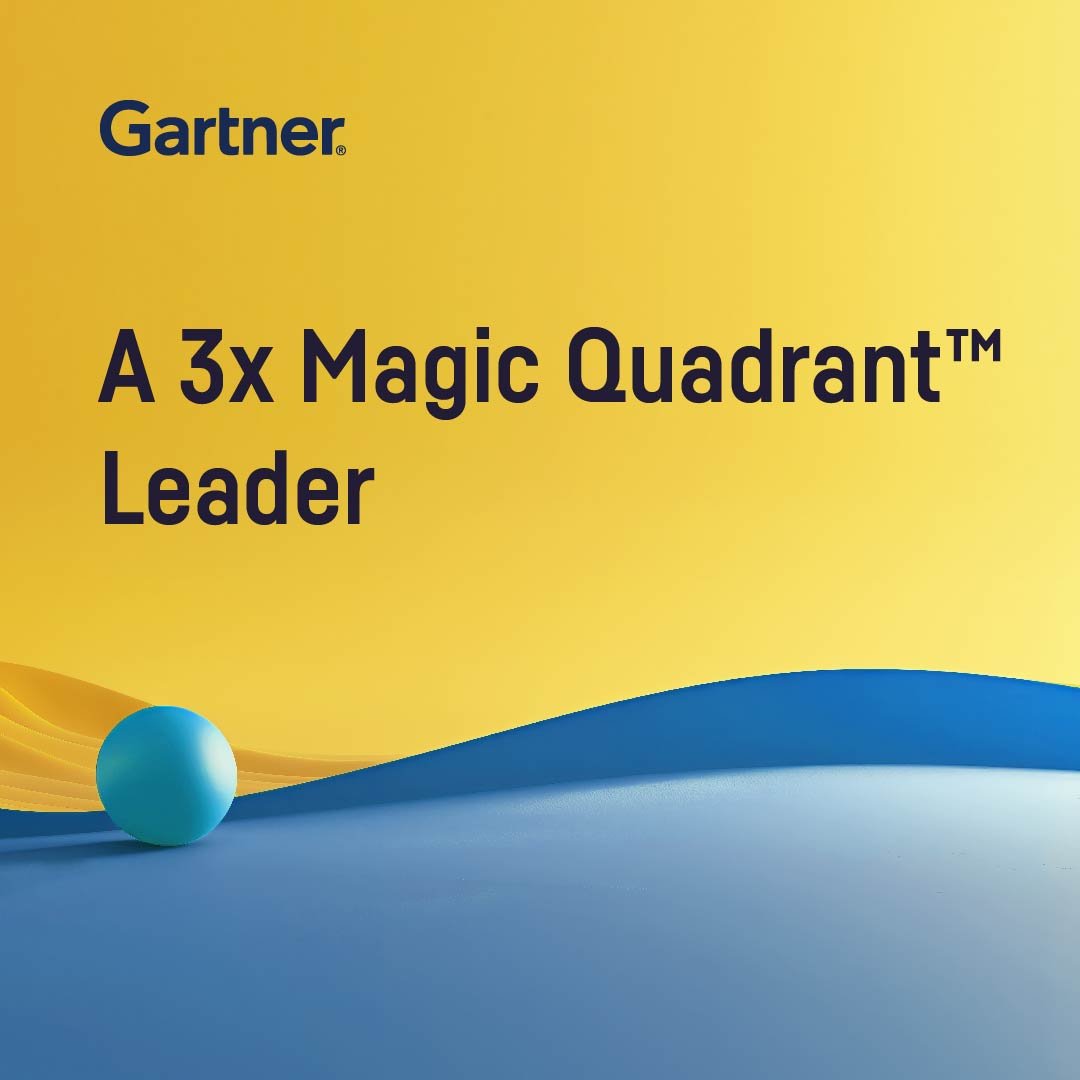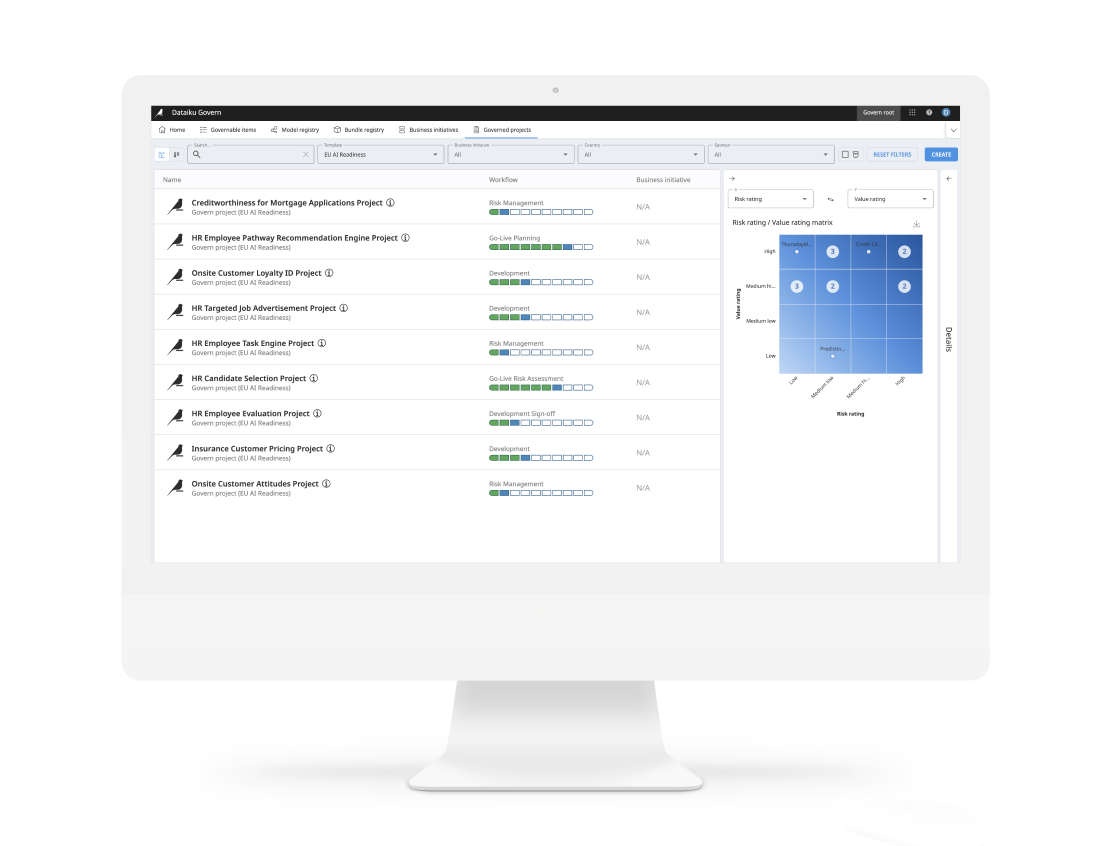Data & AI Governance: What It Is & How to Do It Right
Why Organizations Need Governance
Across nearly every major industry, enterprises are investing more than ever before in advanced analytics and AI-driven data processes. While this is cause for celebration, it also gives rise to a massive challenge in the way of visibility, AI control, and process management. With more teams developing, deploying, and deriving insights from data plus experimenting with generative AI, it is increasingly difficult for teams to manage comprehensive documentation and monitoring, as well as to mitigate operational and/or legal risks.
For this reason, data and analytics stakeholders as well as business and IT leaders alike have begun to focus intently on governance processes and capabilities. AI platforms have emerged as a way to allow everyone across the organization — from data engineers to business analysts and more — to work collaboratively and with a recognized structure of accountability. From small tweaks to a model to major sign-offs, well-built governance operations should grant all stakeholders visibility into every stage of an analytics or AI project’s development.
Why is data and AI governance important? How is data and AI governance defined? Before going further, let’s take a step back and a closer look at why governance has become so critical. Without a clear understanding of needs and challenges, it’s nearly impossible to generate an appropriate framework that reflects business objectives. Here are the five main reasons why organizations need strong data and AI governance. These categories, in turn, are a good basis to start from when building out your own AI and enterprise data and AI governance framework:
Ensure Data Quality & Consistency
Data is at the heart of modern business decisions, making it crucial that the information used is accurate, reliable, and consistent across all teams. Poor data quality can lead to flawed insights and misguided strategies, costing businesses both time and resources. Governance ensures that standards for data quality are clearly defined and consistently applied, allowing stakeholders to confidently base their decisions on trustworthy data.
Moreover, governance frameworks establish processes for managing data updates, corrections, and inconsistencies. This helps prevent data silos, where different teams may use conflicting versions of data, leading to confusion and misalignment. When data quality is upheld through governance, organizations can unlock more value from their analytics and AI initiatives.
Conversely, data quality issues, such as when data definitions are different between tools, can lead to inaccuracy in business intelligence (BI) and data science initiatives which can, in turn, cause the business to focus on the wrong strategic projects.
Mitigate Legal & Compliance Risks
As regulations surrounding data privacy and AI systems continue to evolve, organizations must learn to walk the talk and go from high-level principles to action to implement governance programs at scale. While getting into details on specific regulations is outside the scope of this article, one thing’s for sure: organizations face increasing scrutiny. Failure to comply can result in severe penalties, legal action, and damage to an organization’s reputation. For example, When data is not properly secured or categorized, companies can run afoul of data privacy regulations like California Consumer Privacy Act (CCPA), Health Insurance Portability and Accountability Act (HIPAA), EU AI Act, or General Data Protection Regulation (GDPR), which can lead to hefty fines and negative reputational impact. Governance frameworks are essential for staying ahead of regulatory requirements, ensuring that data and model handling practices are standardized and well-documented.
By implementing governance protocols, organizations can also establish clear accountability for data-related decisions. This includes setting up processes for regular audits, monitoring data usage, and providing evidence of compliance. When governance practices are embedded into data and AI workflows, companies can more effectively manage the risks associated with changing regulatory expectations.
Promote Responsible Use of Data & AI
Proper governance goes beyond compliance to address ethical considerations in data and AI use. It helps organizations establish guidelines for responsible AI development, reduce bias, and ensure that data is used in ways that align with ethical standards and societal expectations.
Clarifying values and ethics across the organization is a challenge in and of itself. Dataiku’s very own RAFT (Reliable, Accountable, Fair, and Transparent) framework for responsible AI can become a significant part of a larger governance framework. This proactive stance is especially important as customers, investors, and regulators increasingly demand transparency and accountability around AI practices.
Maintain Control Over the AI Model Lifecycle
Managing the lifecycle of AI models — spanning from development to deployment and beyond — poses significant challenges. Without governance, tracking model versions, ensuring proper documentation, and monitoring performance can be inconsistent or incomplete. A governance framework brings structure to the AI lifecycle by enforcing version control, audit trails, and ongoing monitoring, which helps maintain transparency and accountability.
Governance also ensures that models remain relevant and effective over time by establishing protocols for retraining and updating models as new data becomes available. This allows organizations to adapt quickly to changes in the business environment while minimizing risks associated with outdated or underperforming models. Through effective governance, companies can better manage the full AI lifecycle and maximize the return on their AI investments.
Streamline Collaboration Across Teams
When multiple teams are involved in data and AI initiatives, misalignment can slow progress and create silos. Governance enables a structured approach, allowing diverse roles to collaborate efficiently while maintaining accountability and visibility into project development.
Imagine you have teams across different business units who all have their own systems to organize their approach to governance, or there’s a patchwork of teams with their own approaches and others operating without strategy. This is all too common, described as a decentralized structure or a federated approach to analytics and AI. And this approach can make sense, especially if data and AI resources are dedicated to specific business functions: Practitioners supporting HR will not demand the same requirements as ones that work on customer-facing products.
But establishing a baseline or foundational governance approach with flexibility for various business lines helps to create some consistency. In turn, this allows for greater efficiencies at the enterprise level, making your programs more scalable and easier to read cross-functionally. This could be your data scientists and AI engineers who need to have a standardized way of monitoring model drift, required information about projects or models, or approaches to beginning new challenger models.
Ultimately, benefits of data and AI governance done well include getting rid of data silos, giving the organization access to high-quality, relevant data — all in a secure way. Organizations can achieve better customer outcomes and operational efficiencies with a good data and AI governance framework and strategy.
AI Governance vs. Data Governance: 4 Key Differences
Having data governance standards as well as AI governance are both crucial for modern organizations, but they serve distinct purposes. Putting together a well-rounded governance strategy requires spotting and understanding the differences between data governance vs. AI governance.
In recent years, companies have made headway centralizing and controlling their data through data catalogs, data inventories, and data collections. Meanwhile, interest in AI (particularly GenAI) has grown exponentially. The rise of machine learning (ML) models, analytics projects, and the use cases in which they are being deployed demands more specific and rigorous governance. Data governance policies were never designed to handle the democratized ML required in the age of AI, necessitating new governance frameworks. This is where AI governance comes into play.
What is AI governance? How are data governance roles defined and why is data governance vs. data management important? What is a data governance operating model and how does it differ from AI governance? Here are four key differences you need to understand:
The Scope of Governance for Data vs. AI Governance
The data governance process focuses on managing an organization’s data availability, usability, integrity, and security. Its goal is to ensure data is accurate, consistent, and used responsibly, adhering to regulations and internal policies. Key capabilities include data quality management, data security, metadata management, data stewardship, and data lifecycle management.
On the other hand, AI governance oversees the processes, policies, and controls surrounding the development and deployment of AI projects. It orchestrates and enforces rules, processes, and requirements that align AI initiatives with organizational objectives. Key activities include model documentation, risk management, bias and fairness assessment, auditability, and accountability of AI systems.
While data and AI governance both have the same underlying goal of enforcing the right frameworks and best practices across the company, AI governance squarely focuses on scaling AI. It is linked with both MLOps and responsible AI principles, from technical issues around data quality governance and ML model maintenance to overall inefficiency, opacity, and risk associated with growing AI initiatives. Ultimately, data and AI governance are a two-way street: good data governance leads to better AI governance, and vice versa.
Understanding and implementing both governance frameworks are essential for organizations to maintain trust and compliance as they scale their AI and data initiatives. AI governance and compliance is inherently broader, encompassing objectives beyond data protection compliance, such as bias prevention and model explainability.
Regulatory Bounds of Data vs. AI Governance
Data governance roles and responsibilities as well as policies are driven by regulations like GDPR, DPA, CCPA, PIPEDA. These, along with other regional or industry-specific data protection laws, focus on privacy and data security. AI governance principles, on the other hand, are governed by emerging regulations specifically targeting AI. This includes the EU AI Act, which addresses ethical considerations and risk management. Industry-specific approaches complement AI-specific regulation.
Why does regulation matter? For one thing, because it’s becoming ubiquitous. Governments globally are advancing regulatory and non-regulatory interventions to shape how organizations build, buy, and deploy AI. For example:
- The U.S. has introduced the NIST AI Risk Management Framework, the AI Bill of Rights, an Executive Order on the Safe, Secure, and Trustworthy Development and Use of Artificial Intelligence. In 2025 with a changing administration, AI regulation is likely to be enforced in an even more piecemeal fashion — all the more need for flexible yet rigorous governance frameworks that can adapt to changing market and regulatory conditions.
- Singapore’s IMDA released AI Verify.
- The U.K. published an AI regulation policy paper and launched the AI Safety Institute.
- The EU AI Act has set a precedent by establishing requirements associated with risk-levels and complementary severe penalties for non-compliance. Understanding the EU AI Act and managing compliance with its requirements through governance practices is becoming a major criterion for any global company operating in Europe.
Operational Implementation of Data Management vs. Data Governance vs. AI Governance
In general, data governance roadmaps are implemented through data policies, centralized data catalogs, data stewardship, and data quality management processes. AI governance plans, on the other hand, tend to be more complex. They encompass diverse objectives, extending from ethical guidelines, risk assessment frameworks, assessing operational efficiency, monitoring value through sign-off and approval workflows, and observability systems for AI applications.
It’s important not to confuse having a data governance plan with having a larger AI governance plan and framework. Indeed, an AI governance framework should be distinct from cataloging datasets. It requires adherence to rules and operational implementation to prevent missteps in AI development and deployment. This is crucial for safely scaling AI and avoiding setbacks due to non-compliance with governance frameworks.
It’s worth noting that AI agents and GenAI applications, powered by large language models (LLMs), might also require additional governance measures to prevent downstream consequences related to risks such as data exposure, hallucination effects, and toxic outcomes.
Stakeholders in Data vs. AI Governance
Data governance programs tend to involve people like data stewards, data teams, IT departments, compliance officers, and business users. As you might expect, AI governance stakeholders can extend much further, requiring a broader range of stakeholders. This might include data scientists, ML engineers, AI engineers, risk managers, ethicists and legal advisors, along with business domain experts.
With all these stakeholders across data and AI governance plans, seamless collaboration is paramount for success. Given the rapid proliferation of AI models, business teams need AI model governance via a unified platform with IT, data science teams, and managers and leaders to share visibility into ongoing projects, performance, and status, facilitating effective prioritization and decision-making.
Go Further
Explore the Full Data Governance Capabilities of Dataiku
See How to Master AI Governance With Dataiku
Explore the Differences Between Data Governance and AI Governance
Discover the Full GenAI Capabilities of Dataiku
Shared Data & AI Governance Challenges
AI and data governance challenges can be quite similar, such as ensuring transparency and traceability across data flows and AI decision making, which are essential for trust and compliance. Both also grapple with managing bias — setting standards for data quality to prevent flawed insights and addressing fairness within AI models. Additionally, ongoing monitoring is a shared hurdle, requiring continuous adaptation to evolving regulations and ensuring accountability, whether by tracking data usage or maintaining AI model performance over time.
The bottom line is that every company wants to be able to scale AI systems and AI models successfully. But it’s not just about AI technology and applications based on ML algorithms. Even democratizing data, which necessitates breaking down silos and providing self-service frameworks, requires good governance.
Ultimately, the goal is creating or generating value from massive amounts of data. At the same time, it’s also about reducing cost and ensuring risk management. These are huge tasks to accomplish and extremely difficult goals to scale in the modern organization because :
- Organizations lack standard processes. Every line of business might have its own unique working process for getting data projects into production.
- There tends to be low traceability. Let’s face it — no one really loves documenting their work. However, if you don’t have the documentation for data pipelines, you don’t have the audit trails that you need to be successful.
- IT organizations lack visibility. You probably have different lines of business and teams working on data or AI projects. Without a central watchtower to monitor projects, you don’t know what’s coming up or what’s already in production.
Data governance services and data governance software can help address these challenges, but they are not a magic bullet. The next section will cover data governance solutions and best practices for expanding to larger AI governance strategies.
Data Strategy & Governance Best Practices
Implementing effective governance requires a strategic approach tailored to both data and AI management. While the challenges, as well as goals of transparency, accountability, and risk mitigation are shared, the specific best practices for AI governance and data governance differ due to the unique challenges each presents.
Data Governance Best Practices
Establishing a strong data governance framework template is a journey, and it’s worth re-evaluating whether you have clear alignment with your overall goals from time to time. Especially as good data governance strategy and strong AI governance ultimately go hand in hand. Here are some general data governance pillars and data governance examples we’ve heard from customers and the industry:
- Understand how to measure success and involve the business in defining goals: A good data governance model and strategy should have clear metrics and KPIs to measure progress over time. Business leaders should also be involved in defining goals, both to ensure organizational alignment and policy enforcement.
- Define clear roles and accountability teams across the data lifecycle: Data isn’t static — it’s transformed, cleansed, deleted, etc., by different users for different purposes. Because of this, you should have a way to build audit trails and data lineage throughout the entire lifecycle, with all users who interact with data so that the right people are accountable.
- Don’t overcorrect on data restrictions: Data access governance and implementing restrictions to a high level can be tempting, however creating bottlenecks to data access can drastically slow down the business, creating a new type of operational risk — that of project failure and falling behind the competition. Before creating new policy restrictions, try to gather information from the business on how the data is used before making decisions so that you know at which level to restrict access.
AI Governance Best Practices
An analytics and AI governance framework enforces organizational priorities through standardized rules, processes, and requirements. These priorities then determine the design, development, and deployment of analytics and AI. A few questions to ask yourself when thinking about your AI governance maturity level:
- Do you have a way to look for bias in your model?
- What are your organization’s ethics principles?
- Do you have a clear process for defining who needs to approve which portions of your pipeline?
- Are you able to monitor those models once they’re in production?
No organization will answer these questions in the same way, which is why no AI governance framework will be exactly the same. But these questions are a good place to start building a model AI governance framework.
Advancing from these foundational governance questions into practical reality requires robust operational implementation. This is where MLOps frameworks (and the more expansive XOps that includes DataOps and LLMOps) become critical. Without effective operational processes to deploy, monitor, and manage AI models, even the most well-designed governance framework will remain theoretical.
These operational systems form the bridge between governance principles and practical implementation, automatically enforcing policies, tracking model behavior, and monitoring data drift. This operational layer, combined with the answers to your foundational governance questions, enables a comprehensive governance framework — one that directly addresses your organization’s specific compliance requirements, audit needs, and risk management priorities. The resulting framework isn’t just theoretical; it’s shaped by and responsive to the actual models you deploy and the real-world challenges they present.
Governance in the Age of GenAI
The future of AI governance is around GenAI and LLMs. What we’re seeing at Dataiku is GenAI is pushing organizations to think about governance in an expedited way. More than ever before, organizations want to make sure they’re building trust in AI. And trust comes through transparency, documentation, and ensuring that AI policies keep up with this constantly evolving landscape.
Of course, ensuring that we govern applications built on top of LLMs in the classic sense is important. That means the right approvers are in place, there is appropriate oversight over the pipeline, etc. There are also some additional LLM-specific governance tools that could make sense, such as an LLM registry to keep evolving model documentation up to date as well as rationalize which models should (or should not) be used for what use cases. But even more important for GenAI is having a human in the loop.
When it comes to putting a human in the loop for GenAI and LLM applications, you need to decide what makes sense. For something like customer-facing, AI-generated emails, which is high risk, it’s probably critical. For other projects, maybe less so.
Essential Data Governance Tools for Establishing Solid Frameworks
AI platforms like Dataiku play a crucial role in building the foundation for robust governance by providing integrated tools for managing data and AI workflows. They can help both enforce established data governance principles as well as establish new frameworks for AI governance, including for both traditional ML and LLM-powered applications.
Here are some key AI platform features you’ll want to look for to ensure that your technology stack is helping you, not working against you, when it comes to governance.
A Central Watchtower
When a project contains dozens, if not hundreds, of moving parts, and when multiple users with different degrees of data access, different coding skill sets, and different objectives are all working on the same processes and datasets, it is essential that everything revert to a single source. As your company scales its AI footprint, centralized program oversight is crucial for maintaining visibility and reducing risk.
With platforms like Dataiku, users gain access to a single place where data and analytics leaders and project managers can track the progress of multiple AI and analytics initiatives and ensure the right workflows and processes are in place to deliver a lifecycle approach for responsible AI.
Your AI platform should double as a central watchtower over your AI and analytics portfolio, and from that unified view, allow you to determine which assets require explicit governance. For data and analytics stakeholders — like risk and delivery managers, and ML engineers — it is especially important that the AI platform enables them to keep model registries. That is, a central inventory of all their models, including both traditional ML as well as LLMs more specifically.
With a central hub providing a view into the many moving parts that make up model development and deployment, governance processes should also enable stakeholders to assess project value and risk using a standardized qualification framework. So it’s not just about preventing risk, but also about value generation and quantification — the core of any good AI program.
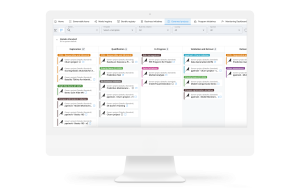
And in the spirit of combining data and AI governance initiatives, an AI platform should also provide a centralized repository that enables the discovery, understanding, and use of common data assets. A data catalog is essential in analytics as it helps data analysts, data scientists, data engineers, and others to find the right data for their analyses quickly and easily.
Using an AI platform to incorporate your catalog more closely with final-mile data, analytics, and AI work provides several key features, including:
- Data discovery: The catalog enables searching and browsing all data assets within an organization, including databases, data warehouses, and file systems. Data scientists or data analysts can quickly find the data they need. Additionally, data engineers get insights into how data is used in data pipelines (called flows, in Dataiku) for every project.
- Data profiling and quality assessment: Extensive data profiling and quality assessment capabilities enable data analysts or data scientists, for example, to assess the quality of their data before using it in their reports or models.
- Collaboration and socialization: The catalog provides collaboration and socialization capabilities that enable data practitioners to share knowledge and insights about the data assets.
Standardized Governance Plans & Workflows
While each team will have unique governance requirements for each project, you shouldn’t be reinventing the wheel every time you want to set up a well-governed workflow. Users should be able to track project statuses across all business initiatives to standardize their approach to AI, create project plans, and leverage workflow blueprints with clear steps and gates to explore, build, test, and deploy AI projects with optimized speed and value for each governed project.
Project owners, for their part, should be able to document and communicate the project’s objectives, its scope, and its potential use cases. And they should be able to attach additional information for all to see and review — such as the details of any business sponsors on the project, or model documentation.
Platforms like Dataiku allow you to tailor your governance processes to each project, while also providing you with pre-built plans and workflows to support your operations from the get-go.
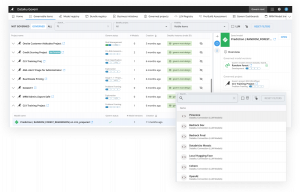
Structured Sign-Off & Approvals
Reviews and sign-offs might be the true core of any good governance operation. Getting stakeholder approval for analytics and AI projects can be challenging to manage and track, but is necessary to ensure both projects and models align with business needs, are auditable, and follow responsible AI best practices.
But there’s an essential yet difficult balance to be struck between efficiency and diligence. If processes are too byzantine and bureaucratic, they’ll never move out of production; if they’re geared for maximum speed, they risk being error-prone. Look for an AI platform where project owners can not only request and collect sign-offs on models or project bundles prior to promoting them to production, but require it. This will keep transparency and fluidity high while reducing bottlenecks to a minimum, all while ensuring audit-readiness on deployment decisions.
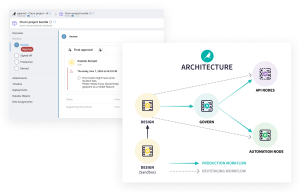
Governance With Dataiku
Good governance is like a great family recipe: It requires several key ingredients, each one of them as important as the last, and it is greater than the sum of its parts. When well-built, an analytics and AI capability will enable users to safely scale AI with oversight and prioritize the data projects and models that deliver the most value.
Let’s imagine what your organization’s governance journey and processes might look like with Dataiku in the picture:
- Compliance or risk factors are clearly stated in the project qualification stage and systematically tracked throughout a project workflow. Reviews and sign-offs are required before a model is pushed into production. Documentation can be uploaded and customized to meet compliance requirements, as there’s a clear timeline and responsibility stated each step of the way.
- Sensitive Data Qualification is documented, centralized, and signed off on in a visible, accessible platform. As required, permissions are developed so the right people have access to such data and others are unable to access or use such data. Audit documentation is centrally located, and proper access can be monitored.
- Technical Model Validation is automated through scenarios and model drift is automatically pulled into the platform for monitoring and sign off. You no longer need to ensure the right people are CC’d on the evaluation emails, no need to search through emails, or link them into additional documentation. The data is visible to anyone who has access to the project in the Dataiku Govern node.
- Model Registry is automatically generated for your portfolio of projects and models and important metadata is continuously updated. Details in the view can drill down and expand to include sponsors, sign-offs, and data like drift metrics. No reminders to fill out the spreadsheet, uncertainty is eliminated if the list is updated, and the process is now visible and transparent.
Why Choose Dataiku for AI Governance?
Only Dataiku unifies end to end model development and governance workflows, bringing together data experts, business experts, and IT/compliance in one place to simplify governance without slowing delivery.
In 2021, Dataiku launched its dedicated AI governance offering — Dataiku Govern — to help organizations gain more control and visibility over AI projects. These capabilities complement the platform’s native data control and data collaboration capabilities, facilitating data sharing and helping organizations master data governance and management.
Since then, Dataiku has expanded its capabilities to adapt to emerging regulatory frameworks. Thanks to its customization capabilities and resources to accelerate time to value, Advanced Govern is the perfect solution for accelerating preparation for current and future regulations, starting with the EU AI Act.
Dataiku’s advanced AI governance features connect with existing systems and seamlessly integrate into production workflows without sacrificing data science teams’ autonomy. Our built-in LLM Mesh, a common backbone for enterprise GenAI Applications, ensures proper GenAI governance frameworks with features like toxicity detection and PII protection.
Conclusion
As companies and organizations invest more heavily in data analytics and continue to increase their AI maturity, the need for governance on analytics and AI projects will only become more pressing. Like a finely tuned watch, the best data operations will comprise many moving parts, some more visible and some less. So it’s essential that teams find the data platforms that best enable them to gain a comprehensive and reliable command over their processes, ensuring that all stakeholders can help scale projects that minimize risk and maximize value.
